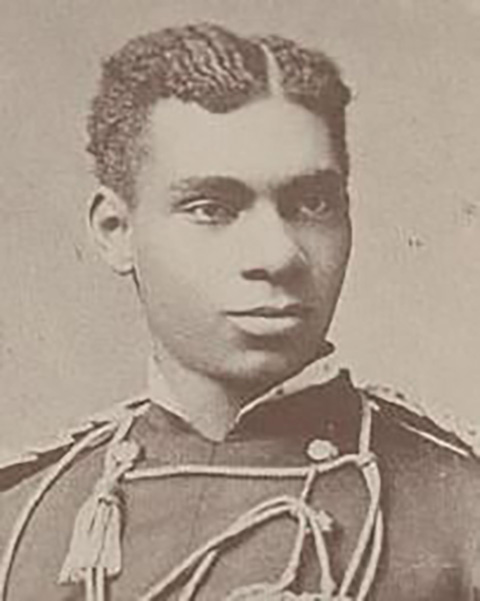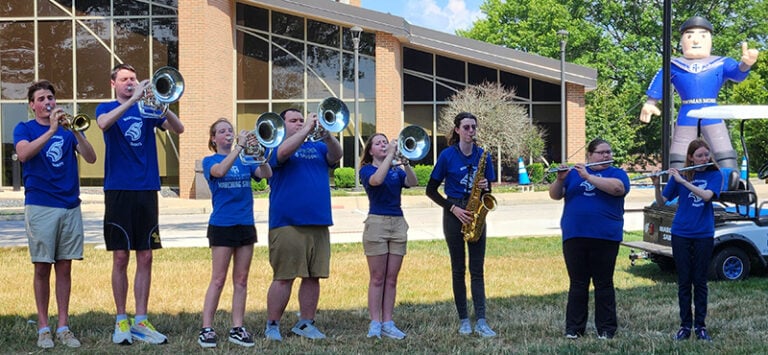Dabbler ducks frequent a wide variety of waters in Kentucky. Waterfowl hunters take them on rivers, streams, small lakes and major reservoirs, farm ponds, cypress sloughs, shallow marshes, agricultural fields and woodlands flooded by backwater from streams, or standing water from heavy rains.
Here’s some life history information and observations on five high-profile species:
Mallard
The Mallard (Anas platyrhynchos) is Kentucky’s top duck, the dabbler species most often taken by hunters during waterfowl season. Last season hunters bagged 38,287 Mallards, according to the U.S. Fish and Wildlife Service.
The male Mallard, the drake, called a “greenhead” by hunters, is one of the most recognizable of all migratory waterfowl.

The male’s plumage is distinctive. A white ring around the neck separates its green iridescent head from its chestnut-brown chest that contrasts with its gray sides, brownish back, and black rump.
The speculum, a bright patch of plumage on its wings, is violet-blue, bordered by black and white. The outer tail feathers are white. The bill is yellow to yellowish-green and the legs and feet are coral-red.
The female Mallard, the hen, affectionately referred to by hunters as a “suzy,” is a mottled brownish. Her speculum, like the drake, is violet-blue, bordered by black and white.
The crown of her head is dark brown with a darker stripe running through the eye. The remainder of the head is lighter brown. The bill is orange splotched with brown, and the legs and feet are orange.
The outer feathers of both sexes are waterproof, and beneath is a fluffy layer of down that keeps them warm in cold weather.
Adult male Mallards weigh slightly more than females, averaging about 2.7 pounds, and they stand slightly taller. Wingspans for both sexes easily exceed 30 inches.
Mallards are present in all four waterfowl flyways. They winter, east to west, from coastal South Carolina, Georgia, Alabama, Mississippi, Louisiana, Texas, and Mexico to Baja California. The greatest concentrations move from Manitoba and Saskatchewan through the Midwestern U.S. down the Mississippi Valley.

Mallards can fly 40 miles per hour, and with a strong tail wind, may travel 800 miles in a day, flying as high as 2,000 feet, sometimes higher.
They are one of the latest fall migrants, yet they have an extended migration period, which lasts from late summer to early winter, depending on how far north their breeding grounds are.
The Mallard’s diet consists of aquatic vegetation, insects, worms, and grain crops like wheat and corn.
They nest throughout the northern reaches of the continent, from Alaska, throughout central Canada, to North Dakota, northern Minnesota and Wisconsin, to Maine, northern New York, Vermont, and New Hampshire, into Canada’s Maritime provinces.
Mallards choose new mating partners each fall, staying together throughout the winter and into the spring mating season. Once mating season has ended, the male mallard leaves and has no involvement in caring for their offspring.
The female builds a nest out of breast feathers and twigs near a body of water. She may lay a clutch of as many as 13 eggs and incubates them for a month.
Once the ducklings hatch, they are immediately taken to water for safety. Mallard ducklings are precocial, meaning they know how swim and feed right after they are hatched.
The ducklings will follow their mother for the next 50 to 60 days, while maturing and developing their ability to fly. Mallards reach breeding age after a year, and can live as long as 10 years in the wild.
American Black Duck
The American Black Duck (Anas rubripes) is a regional migrant prized by hunters because of its scarcity.
They are most often taken in the eastern third of Kentucky while hunting the Ohio River, its backwaters and tributaries, from Cincinnati upriver to Ashland. Last season hunters bagged just 614 Black Ducks, according to the U.S. Fish and Wildlife Service.
This large dabbling duck in the family Anatidae was first described in scientific literature in 1902 by William Brewster, an American ornithologist and naturalist.
Since the 1950s Black Duck populations have declined. Studies suggest the mallard’s steady eastward expansion has resulted in hybridization, mallards breeding with Black Ducks, and increased competition between the two species.
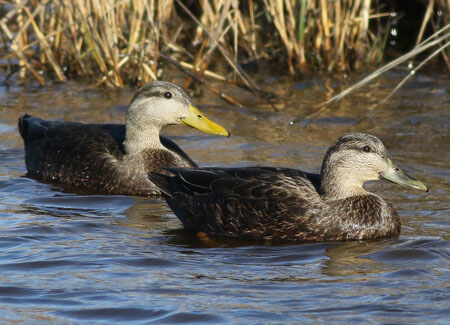
Black ducks are similar to mallards in size, and resemble the female mallard in coloration, though the black duck’s plumage is darker. The male and female Black Duck look a lot alike, but the male’s bill is yellow while the female bill is a dull green.
The Black Duck’s head is slightly lighter brown than its dark brown body, and the speculum (wing patch) is iridescent violet-blue with predominantly black margins. In flight, the white underwings can be seen in contrast to the dark brown body.
Males are slightly larger than females, standing 22 inches tall, and weighing about 2.7 pounds, with a 35 to 37-inch wingspan.
Waterfowl hunters often refer to black ducks as “black mallards.”
The black duck feeds in water, on land and is omnivorous.
Its diet varies, depending on the season and habitat — inland or coastal.
In fresh water, they feed mainly on plant material, including seeds, leaves, roots, berries, pond weeds and sedges. Its animal diet includes snails, mussels, small fish, and amphibians. Young ducklings eat many insects.
Black Ducks are present in the Atlantic and Mississippi flyways. The highest populations are along the Atlantic coast. They are hardy birds that winter farther north than most dabbling ducks.
Their breeding grounds are mostly in eastern Canada, but includes the northernmost reaches of Minnesota, Michigan, New York, Vermont, New Hampshire and Maine.
Fall migration is often late season, as waters freeze, and Black Ducks migrate at night. Most Black Ducks winter from Iowa, south to Tennessee, east to North Carolina and up the Atlantic coast, but not in large numbers throughout the deep South.
Young Black Ducks fledge in about two months, and are abandoned by the female about that time.
Older birds sometimes pair up in early fall and remain together until following summer. Nest sites are usually near water, on banks or small islands of lakes of wetlands, among clumps of dense vegetation. The female builds the nest, a shallow depression of plant material, lined with down.
Female lays and hatches about 6 to 12 creamy white eggs, with a greenish buff. Incubation is typically 26 to 29 days.
All eggs typically hatch in space of a few hours. The female Black Duck leads her young to water, often after dark, and the ducklings find their own food. The young fledge in about two months, and are abandoned by the female about that time.
Wood Duck
The Wood Duck (Aix sponsa) is a homegrown duck, nesting throughout the state in trees along creeks, rivers, and wetlands, and in reservoirs where flooded timber is present.
A medium-sized duck, Wood Ducks weigh about 1 1/2 pounds, with adults measuring about 17 to 20 inches long. Broad, relatively short wings enable the Wood Duck to made acrobatic twists and turns while flying through timber.
In the summer both sexes are in eclipse plumage, a drab grayish-brown coloration. The adult male’s winter plumage is distinctive — a magnificent blend of green, rust, yellow, black, and tan, accented with white.
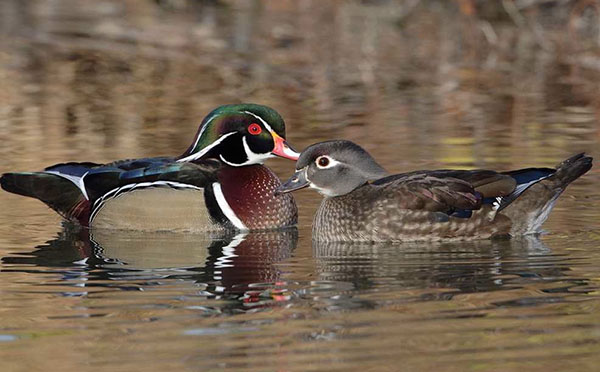
Wood Ducks eat aquatic plants and their seeds, and the seeds of trees and shrubs, also insects and crustaceans.
Acorns are a major part of their diet during the fall migration in the Midwest and South.
Young feed mainly on insects and other invertebrates.
The largest percentage of Wood Ducks breed in the central and eastern U.S., with the highest densities occurring in the Mississippi Flyway states. Some of the wood ducks in the Pacific Flyway breed in southern Canada.
In recent decades, the Wood Duck’s breeding range has expanded westward into the Great Plains region, where wooded riparian corridors are available.
East of the Mississippi River, they are year-round residents in states from Kentucky southward.
Wood Ducks are cavity nesters, raising their young in trees above, or near water. The average clutch size is 10 to 15 eggs.
They also take readily to nest boxes.
Eggs are dull white to pale buff. Females frequently lay eggs in several nests. Incubation is by female only, and lasts 25 to 35 days.
Ducklings remain in nest until the morning after hatching, then they claw their way to the cavity entrance, and jump to the water or ground below.
The female tends the young for five to six weeks, and sometimes two or more broods may combine. The young are capable of flight at about 8 to 9 weeks.
In the northern reaches of their breeding range, they raise one brood per year, sometimes two broods a year, farther south.
Last season hunters in Kentucky bagged 5,733 Wood Ducks, according to the U.S. Fish and Wildlife Service.
Gadwall
The Gadwall (Anas strepera) is medium-sized duck, with no bright distinctive coloration, which can make identification on the wing challenging in low light.
Males are slightly larger, about 21 inches, and weigh a few ounces more than females, about 2 pounds, with a wingspan averaging more than 30 inches.

Male are gray-brown with a white belly and a black rump. In flight, their white speculum, and the chestnut/black colorations of their wing coverts, the smaller feathers covering the bases of the flight feathers, are distinguishing characteristics. The bill is slate-gray and the legs and feet are yellow.
Females are similar to males, but have a mottled brown appearance, a dark bill rimmed in orange, and a smaller white speculum on their wings.
Vocalizations include duck-like quacks, similar to a mallard, chatters and whistles.
Gadwalls are present in all four flyways, but are most numerous in the Mississippi and Central Flyways.
They winter, east to west, from coastal Maryland and Virginia, south to Florida and southern Mexico, west to Baja California, and north to coastal California, Oregon, Washington and British Columbia.
The largest concentration of wintering Gadwalls are in southern two-thirds of the U.S., as far north as southern Iowa, southern Illinois, Missouri, southern Indiana and western Kentucky, south to Oklahoma, Texas, Louisiana, Mississippi, and Alabama.
Last season hunters in Kentucky bagged 8,394 Gadwalls, the second highest total for dabbler ducks taken in the state, according to the U.S. Fish and Wildlife Service.
Gadwalls migrate in flocks, but not a long distance at a time. They are found in a variety of habitats, including wetlands, farm ponds, large reservoirs, and coastal estuaries.
Aquatic vegetation makes up the majority of the Gadwall’s diet.
As a result, they are often found feeding far from the shoreline, in deeper water than most other dabbling ducks. They eat pondweed, naiad, water milfoil and algae, as well as the seeds of pondweed, and smartweed. Aquatic invertebrates, such as crustaceans and midges, are also consumed.
The breeding grounds of the Gadwall are scattered, in Canada and the U.S.
This includes coastal Alaska, eastern British Columbia, Alberta, Saskatchewan, Manitoba, and some areas in Ontario, Canada. In the Lower 48 states the Gadwall breeds in Montana, Wyoming, and parts of several Great Basin states to the south, east to North and South Dakota, and Minnesota.
Gadwalls nest near seasonal and semi-permanent wetlands, mainly in the grasslands of prairies.
They begin breeding later than most duck species.
The paired male and female fly together looking for a suitable nest site, on an island or along a weedy shoreline.
The nest, built by the female, is in a shallow depression, constructed of grasses and weeds, lined with down. Sometimes several females use the same nest.
The female lays 7 to 13 white eggs, and she incubates them for 24 to 27 days. The young leave the nest shortly after hatching, and are led to water, where they find their own food.
About 48 to 59 days after hatching, the young are capable of flight.
American Wigeon
The American Wigeon (Mareca americana) is a compact duck with a round head. They measure 17 to 23 inches long, with a 30 to 36-inch wingspan, and weigh about 1.129 to 2.932 pounds.
The American Wigeon has two adult molts a year plus a juvenile molt in the first year.
Their blue-gray bills are tipped in black.
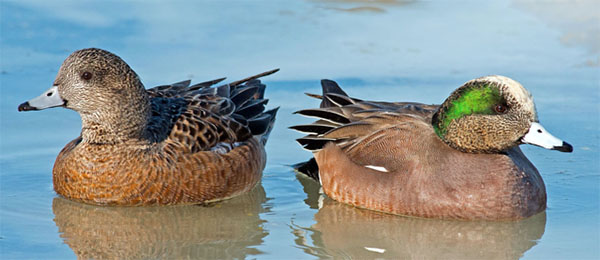
The breeding male (drake) is a striking bird with a mask of green feathers around its eyes and a cream-colored cap running from the crown of his head to his bill. This white patch gives the wigeon its common name, “baldpate.”
His belly is also white. In flight, drakes can be identified by the large white shoulder patch on each wing. These white patches flash as the birds bank and turn. In nonbreeding (eclipse) plumage, the drake looks more like the female.
Since about the 1930s their breeding range has expanded eastward in Canada and the northeastern states in the U.S.
Their preferred habitat is marshes, lakes, bays, and fields. In their summer breeding grounds they inhabit inland marshes, especially larger marshes.
During migration and on their wintering grounds they prefer coastal estuaries, fresh or salt marshes, inland lakes and larger ponds.
While most dabbling ducks are denizens of the shallows, American Wigeons spend much of their time in flocks grazing on land. They also spend more time in deep water, where they get much of their food by stealing it from other birds such as coots or diving ducks.
The American Wigeon migrates in flocks, mostly by day. In summer, when males leave their mates, they may fly great distances to large open marshes where they will stay while going through the flightless stage of their molt.
Females lay 8 to 11 eggs, sometimes 5 to 12 whitish eggs. Incubation is by the female only, for 23 to 24 days. Male usually departs before eggs hatch.
The young leave the nest shortly after hatching, and feed themselves. The female remains with the brood for much of their pre-flight stage. Young are capable of flight 45 to 63 days after hatching.
American Wigeons eat aquatic plants such as pondweeds, sedges, wild celery, eelgrass, and algae, also some insects and snails. On land, they graze on young grass shoots, seeds and waste grains. Young ducklings eat mostly insects.
Pair formation begins on the wintering grounds and most older birds are paired before spring migration.
Several males often court one female. In one display, a male extends his neck forward with head low, bill open, while raising the tips of his folded wings, revealing white wing patches.
Wigeons begin nesting later in season than most dabblers. They nest on dry land, sometimes on an island, usually within 100 feet of water but as far away as a half mile.
The nest site is concealed by tall vegetation. The nest, built by the female, is a shallow depression filled with grasses and weeds, and lined with down.
According to the U.S. Fish and Wildlife Service Migratory Bird Hunting Activity and Harvest Report for the 2022-23 season, Kentucky has 7,400 active duck hunters. They bagged 71,500 ducks while hunting a total of 42,700 hunter days afield.
For season dates and regulations for Kentucky’s 2023-24 waterfowl season, visit fw.ky.gov/Waterfowl-Hunting.














